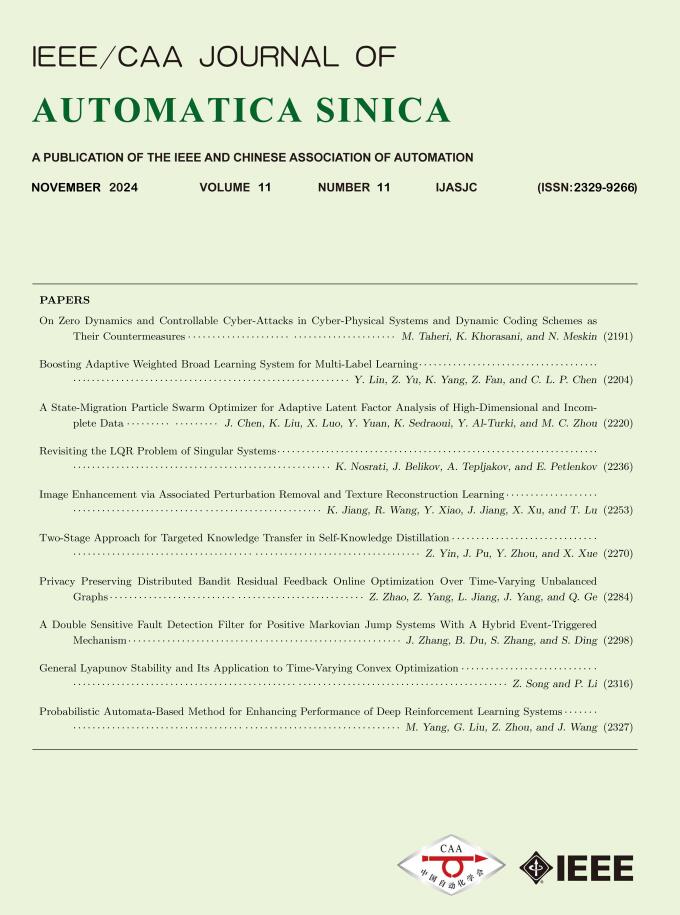 Volume 11
Issue 11
Volume 11
Issue 11
IEEE/CAA Journal of Automatica Sinica
| Citation: | J. Wang, W. Li, and X. Luo, “A distributed adaptive second-order latent factor analysis model,” IEEE/CAA J. Autom. Sinica, vol. 11, no. 11, pp. 2343–2345, Nov. 2024. doi: 10.1109/JAS.2024.124371 |

| [1] |
Y. Koren, R. Bell, and C. Volinsky, “Matrix factorization techniques for recommender systems,” Computer, vol. 42, no. 8, pp. 30–37, Aug. 2009. doi: 10.1109/MC.2009.263
|
| [2] |
H. Han, T. Zhang, M. L. Benton, C. Li, J. Wang, and J. Li, “Explainable t-SNE for single-cell RNA-SEQ data analysis,” 2022. [Online], Available: https://www.biorxiv.org/content/10.1101/2022.01.12.476084v1.
|
| [3] |
Y. Zhou, X. Luo, and M. C. Zhou, “Cryptocurrency transaction network embedding from static and dynamic perspectives: An overview,” IEEE/CAA J. Autom. Sinica, vol. 10, no. 5, pp. 1105–1121, May 2023. doi: 10.1109/JAS.2023.123450
|
| [4] |
X. Luo, M. Zhou, S. Li, Y. Xia, Z. You, Q. Zhu, and H. Leung, “Incorporation of efficient second-order solvers into latent factor models for accurate prediction of missing QoS data,” IEEE Trans. Cybern., vol. 48, no. 4, pp. 1216–1228, Apr. 2018. doi: 10.1109/TCYB.2017.2685521
|
| [5] |
A. H. Khan, S. Li, D. Chen, and L. Liao, “Tracking control of redundant mobile manipulator: An RNN based metaheuristic approach,” Neuroco mput., vol. 400, pp. 272–284, Aug. 2020. doi: 10.1016/j.neucom.2020.02.109
|
| [6] |
S. B. Joseph, E. G. Dada, A. Abidemi, D. O. Oyewola, and B. M. Khammas, “Metaheuristic algorithms for PID controller parameters tuning: Review, approaches and open problems,” Heliyon, vol. 8, no. 5, May. 2022.
|
| [7] |
A. H. Khan, X. Cao, S. Li, V. N. Katsikis, and L. Liao, “BAS-ADAM: An ADAM based approach to improve the performance of beetle antennae search optimizer,” IEEE/CAA J. Autom. Sinica, vol. 7, no. 2, pp. 461–471, Mar. 2020. doi: 10.1109/JAS.2020.1003048
|
| [8] |
J. Tang, G. Liu, and Q. Pan, “A review on representative swarm intelligence algorithms for solving optimization problems: Applications and trends,” IEEE/CAA J. Autom. Sinica, vol. 8, no. 10, pp. 1627–1643, Oct. 2021. doi: 10.1109/JAS.2021.1004129
|
| [9] |
F. Han, W. Chen, Q. Ling, and H. Han, “Multi-objective particle swarm optimization with adaptive strategies for feature selection,” Swarm Evol. Comput., vol. 62, p. 100847, Apr. 2021.
|
| [10] |
Q. Yang, W. Chen, J. Deng, Y. Li, T. Gu, and J. Zhang, “A level-based learning swarm optimizer for large-scale optimization,” IEEE Trans. Evol. Comput., vol. 22, no. 4, pp. 578–594, Aug. 2018. doi: 10.1109/TEVC.2017.2743016
|
| [11] |
R. Lan, Y. Zhu, H. Lu, Z. Liu, and X. Luo, “A two-phase learning-based swarm optimizer for large-scale optimization,” IEEE Trans. Cybern., vol. 51, no. 12, pp. 6284–6293, Dec. 2021. doi: 10.1109/TCYB.2020.2968400
|
| [12] |
J. Martens, “Deep learning via Hessian-free optimization,” in Proc. 27th Int. Conf. Mach. Learn., Jun. 2010, pp. 735–742.
|
| [13] |
Q. Liu, “Order-2 stability analysis of particle swarm optimization,” Evol. Comput., vol. 23, no. 2, pp. 187–216, Jun. 2015. doi: 10.1162/EVCO_a_00129
|
| [14] |
W. Yue, Z. Wang, J. Zhang, and X. Liu, “An overview of recommendation techniques and their applications in healthcare,” IEEE/CAA J. Autom. Sinica, vol. 8, no. 4, pp. 701–717, Apr. 2021. doi: 10.1109/JAS.2021.1003919
|
| [15] |
F. M. Harper and J. A. Konstan, “The movielens datasets: History and context,” ACM Trans. Interact. Intell. Syst., vol. 5, no. 4, pp. 1–19, Jan. 2016.
|
| [16] |
Y. Zhang, Z. Zheng, and M. R. Lyu “WSPred: A time-aware personalized QoS prediction framework for web services,” in Proc. 22nd IEEE Int. Symp. Softw. Rel. Eng., vol. 15, no. 3, pp. 1334–1344, May–Jun. 2022.
|
| [17] |
I. Cantador, P. Brusilovsky, and T. Kuflik, “Second workshop on information heterogeneity and fusion in recommender systems (HetRec 2011),” in Proc. 5th ACM Conf. Rec. Syst., Oct. 2011, pp. 387–388.
|
| [18] |
K. Goldberg, T. Roeder, D. Gupta, and C. Perkins, “Eigentaste: A constant time collaborative filtering algorithm,” Inf. Retrieval, vol. 4, no. 2, pp. 133–151, Jul. 2001. doi: 10.1023/A:1011419012209
|
| [19] |
X. Luo, M. Zhou, Y. Xia, and Q. Zhu, “An efficient non-negative matrix-factorization-based approach to collaborative filtering for recommender systems,” IEEE Trans. Ind. Informat., vol. 10, no. 2, pp. 1273–1284, May 2014.
|
| [20] |
X. Luo, M. Zhou, S. Li, Z. You, Y. Xia, and Q. Zhu, “A nonnegative latent factor model for large-scale sparse matrices in recommender systems via alternating direction method,” IEEE Trans. Neural Netw. Learn. Syst., vol. 27, no. 3, pp. 579–592, Mar. 2016. doi: 10.1109/TNNLS.2015.2415257
|
| [21] |
S. Sedhain, A. K. Menon, S. Sanner, and L. Xie, “AutoRec: Autoencoders meet collaborative filtering,” in Proc. 24th Int. Conf. World Wide Web, May 2015, pp. 111–112.
|
| [22] |
X. He, K. Deng, X. Wang, Y. Li, Y. Zhang, and M. Wang, “LightGCN: Simplifying and powering graph convolution network for recommendation,” in Proc. 43rd Int. ACM SIGIR Conf. Res. Develop. Inf. Retr., Jul. 2020, pp. 639–649.
|